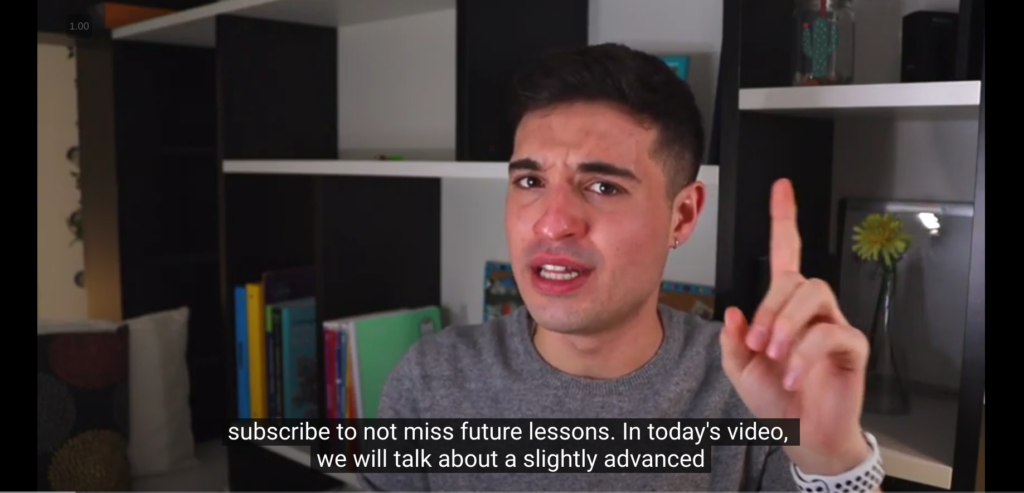Italian Subjunctive for Beginners
Buongiorno e benvenuti a tutti! Siete pronti per imparare un po'? Iniziamo!
The subjunctive mood, known as il congiuntivo, is a beast for everyone learning to speak Italian.
That's even the case once you've started to get the hang of the other, more basic Italian verb conjugations. Even though the subjunctive follows patterns, just like all the other verb conjugations that exist in Italian, there's something about the subjunctive that just makes it a bit trickier to get the hang of.
So, if this is your first time visiting our site, and you haven't started learning how to conjugate Italian verbs yet, don't try to run before you can walk! Head on over to check out our article on the subjunctive here then come back here to start tackling the subjunctive. Don't worry, this article isn't going anywhere!
Many natives even have trouble with learning how and when to use it! Here's an example of Luigi Di Maio, a leading politician, making a mistake during a speech. Instead of using the subjunctive, he first uses a different verb mood! You can hear him say "sarebbero state" and then correct himself by using the proper subjunctive "fossero state". That verb mistake can change the entire meaning of the sentence!

Se non ci fossero state situazioni come queste. Perdonatemi."
Don't worry, though, if you want to get the subjunctive down, all you need is just a little bit of study, hard work, and practice!
The Italian Subjunctive, when do we use it?
First thing's first, when do you use the subjunctive verb tense in Italian? "Learn Italian with Teacher Stefano" offers a great introductory video that answers when the subjunctive should be used. The subjunctive is used to express: doubts, possibilities, uncertainties, and personal feelings about things.

In other words, anytime you're talking about something that you don't know for sure, you'll probably use one of the Italian subjunctive forms. For example, if you want to say "I think you're a good student." You would use the subjunctive "Io penso che tu sia un bravo studente".
You often hear the subjunctive used in more professional videos and films, particularly when there are script writers involved who are grammar experts. However, you can still hear it used in everyday conversation, as well. In fact, many YouTubers who know that they have a young audience will make sure to use the correct form of the subjunctive, since it's complicated to learn even for native speakers! If you want to learn more about Italian YouTubers, then check out our article covering our top picks for people learning Italian!
In this video, you hear the speaker say "Chi crede che io sia?" This is another good example of when to use the subjunctive. He's asking his audience who people think he is but he knows they can't be completely sure about their answer. The other speakers in the conversation then respond using the subjunctive for this same reason!

"Molti, dicono Giovanni Battista. Non vogliono ammettere che sia morto."
That's a broad spectrum to work with, I know, but it gets easier. I promise! Learning languages is tough and if you overthink which verb form to use, you're liable to confuse yourself more than you have to when it comes to speaking Italian in real life!
An easy first step to understanding when you need a subjunctive verb is to remember that the Italian subjunctive verb will never be in the main clause (a.k.a. the main verb) of your phrase. It's always placed in the subordinate clause of sentences introduced by the word "che".
FAQ: Do you use congiuntivo after Secondo me?
Typically, you use the congiuntivo (the subjunctive) when you're talking about things that aren't certain. However, there are a few exceptions to this rule that you should remember. Secondo me uses the indicative form even though it means "in my opinion". Even though an opinion isn't fact, it's more concrete. Other similar expressions that need the indicative and not the subjunctive for this reason are: per me and a mio avviso.
How many types are there?
If you've been studying the Italian language and its grammar for a while, (which I bet you have if you're trying to figure out how the subjunctive mood works!) you probably know by now that many Italian verb forms can be subcategorized. The subjunctive is no different!
FAQ: Is subjunctive a tense or a mood?
The subjunctive is a verbal mood. That means it helps get across the attitude of the person speaking. In this case, the speaker has an attitude of being unsure. Since the subjunctive is a mood, it offers different verb tenses to use depending on the time of the action being talked about.
There are two simple forms:
- present subjunctive (il congiuntivo presente)
- imperfect subjunctive (il congiuntivo imperfetto).
There are also two compound forms:
- the past perfect subjunctive (il congiuntivo passato)
- the pluperfect subjunctive (il congiuntivo trapassato).
These compound verbs are formed by using the subjunctive form of an auxiliary verb (usually the verb essere or the verb avere) along with the past participle of the verb you want to use. If you've studied the present perfect (il passato prossimo) you're already used to this sort of combination verb tense.
Since the subjunctive mood is so complicated, don't worry about learning all of it at once. To get started, we'll just be focusing on what is considered the easiest form, the present subjunctive.
The present subjunctive
The present tense for the Italian subjunctive is pretty straightforward. You use it for expressions of possibilities, doubts, etc. in the present tense.
How do we conjugate regular Italian verbs?
Regular Italian verbs are always the easiest to learn. Once you learn the conjugation pattern for each of the infinite verb endings (-are, -ere, and -ire), you know the conjugation for all the other regular verbs with the same ending in their infinite form.
For the present subjunctive, regular verbs have the following conjugation pattern:
| -ARE VERBS (e.g., mangiare) | -ERE VERBS (e.g., mettere) | -IRE VERBS (e.g., dormire) | |
|---|---|---|---|
| che io | mangi | metta | dorma |
| che tu | mangi | metta | dorma |
| che lui/lei | mangi | metta | dorma |
| che noi | mangiamo | mettiamo | dormiamo |
| che voi | mangiate | mettiate | dormiate |
| che loro | mangiano | mettano | dormano |
As with every conjugation you have to learn, there's a lot of memorizing that has to be done before things start to click and become second nature. However, luckily, with the subjunctive, there's not too much memorizing compared to other verb moods!
The singular forms are always conjugated the same way, no matter if you use the "io" form, the "tu", or the "lui/lei" (or impersonal expressions which would use "egli"). The "noi" form is also always the same as the present indicative.
So, now that you're on a roll, let's take a look at the subjunctive form for two important verbs you've already likely become very familiar with, "essere" (to be) and "avere" (to have).
FAQ: How do you know if a sentence is subjunctive?
Figuring out if a sentence is in the subjunctive while you're still learning isn't that difficult. There are a few things to look out for. If you see the word "se", for example, the sentence is likely in the subjunctive mood. However, another giveaway is to look at the structure of the sentence. A subjunctive will usually have an indicative clause (a phrase or part of a sentence with a verb and subject) and another that is subjunctive that is introduced by "se" or other similar words or expressions.
Subjunctive Auxiliary verbs
When you started learning Italian, you became acquainted with "essere" and "avere". As you've already learned, these two verbs are important parts of the entire Italian language. That includes expressions of possibilities in the present subjunctive. Let's look at how these two verbs are conjugated in the present tense.
The subjunctive essere and avere are conjugated:
| Essere | Avere | |
|---|---|---|
| che io | sia | abbia |
| che tu | sia | abbia |
| che lui/lei | sia | abbia |
| che noi | siamo | abbiamo |
| che voi | siate | abbiate |
| che loro | siano | abbiano |
For now, just worry about memorizing the conjugation for "essere" and "avere" for expressing possibilities, doubts, etc. about what you (or someone else) have or that are in the present tense. Like "Spero che lui abbia un cane" (I hope he has a dog) or "Immagino che lei sia stanca" (I imagine that she is tired). Once you have these forms down, you'll be halfway to learning how to form the pluperfect, past perfect, and imperfect subjunctive forms in the future!
Other Irregular Verbs
Unfortunately, as you've probably already learned, Italian grammar is full of verbs that typical conjugations don't apply to. It can be discouraging to have to memorize all new conjugations that don't fit the normal pattern, especially for something as complicated as the subjunctive mood. Don't fret, though! As you practice, you'll eventually start to remember which verbs don't follow the same patterns as their regular counterparts. To get you started, let's check out a few examples you're likely to use and come across.
| Andare | Venire | Rimanere | |
|---|---|---|---|
| che io | vada | venga | rimanga |
| che tu | vada | venga | rimanga |
| che lui/lei | vada | venga | rimanga |
| che noi | andiamo | veniamo | rimaniamo |
| che voi | andiate | veniate | rimaniate |
| che loro | vadano | vengano | rimangano |
Some things to remember
I know there's a lot of information in this article already, but let's bring this full circle! That way you'll be sure you have all the information you need to practice this tricky verb mood on your own!
The subjunctive mood is always introduced by the Italian word "che". However, there are some occasions where you might see or need to use the word "che" but you don't need a subjunctive verb. For example with comparisons like "Sono più saggia che vecchia". You only use the subjunctive for the secondary clause in a sentence, and only if you're expressing something that isn't certain.
It's also important to remember that the subjunctive in Italian is used to express opinions. That means you would use the subjunctive for phrases like "mi piace che" (I like) , "credo che" (I believe), "penso che" (I think), and "ho l'impressione che" (I have the impression).
Keep in mind, if you use phrases like "Sono certo che" (I'm sure) or "È certo che" (it is sure), you're still expressing an opinion, and need to use the subjunctive.
FAQ: Does the subjunctive exist in English?
The subjunctive does exist in English. However, it often isn't used in everyday speech. That makes it a mood that's sometimes more difficult to learn in languages that regularly use this verb mood.
In conclusion
The subjunctive mood can be a difficult one to figure out! It deals with things that aren't concrete, which can already be difficult to wrap your head around. Add in the different categories of verb conjugations, and it can be a daunting thing to learn!
With the help of video creators like "Learn Italian with Teacher Stefano" you'll get the hang of it! After all, practice makes perfect!
In the meantime, this quick introduction has given you all you need to start tackling the Italian subjunctive as a beginner! Buona fortuna!
FAQ: Is subjunctive mood necessary?
In Italian, the subjunctive mood is still used often, especially in the written language. It's necessary to express doubts, for example. It's a difficult mood to learn, though, so people will still understand you if you make a mistake or if you would prefer to use the indicative mood until you get the hang of the subjunctive.





